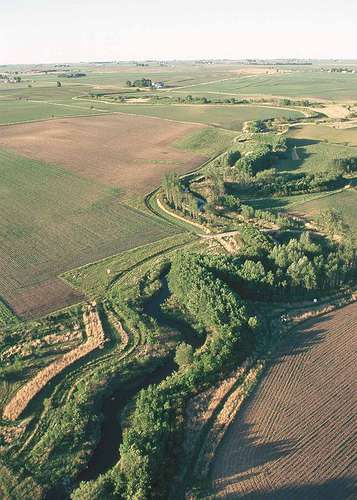Governor Dayton's buffer initiative

Stream buffers, like this one along Bear Creek in Story County Iowa, filter pollution from farm runoff and improve water quality, habitat, air quality, and climate while helping to prevent erosion and reduce the impacts of flooding.
Photo: Wikimedia Commons
In what may be one of the most important state conservation proposals in decades, Governor Dayton recently announced an initiative to require all of Minnesotas rivers and lakes to have a 50-foot protective buffer of natural vegetation along the shore.
In his announcement, Dayton acknowledged that his proposal would face opposition, but stated that The land may be yours, but the water belongs to all of us.
Buffer benefits
Expanding the practice of shoreland buffers presents an enormous opportunity to improve water quality and the states natural resources. These strips of natural vegetation provide several important benefits:
- Buffers improve water quality and fisheries: buffers serve as excellent natural filters to reduce excess sediment, phosphorus, and pesticides that pollute many of Minnesotas waterways.
- Buffers provide key habitat for many species of game and non-game wildlife including pheasants, migratory birds, monarchs and other pollinators, and amphibians.
- Buffers slow down water running off the land to increase infiltration, reduce destructive peak flows and restore natural hydrology.
- Perennial buffer vegetation naturally reduces the impacts of climate change.
- Perennial biofuel crops could be planted within the buffer area and harvested for biofuel production. This would provide farmers with a second income stream while diversifying Minnesota's energy economy and enhancing farm profits.
Considering these benefits, FMR and our partners have applauded the Governor for his bold leadership on this issue.
Poor enforcement of existing rules
Minnesota already has some buffer rules in place to protect streams and agricultural drainage ditches.
- State Statute (Minnesota Rule 6120.3300) already requires a 50-foot buffer separating row-crop agriculture from public waters. While this statute has been in place for decades, local enforcement has been inconsistent at best. While some counties have enforced the rule, a 2014 study by the Environmental Working Group (EWG) found that only 18% of agricultural parcels in the Minnesota River basin had the full 50-foot buffer in place.
- Minnesota statute (Minn Stat 103E.021) also requires a 16.5-foot buffer along agricultural drainage ditches. However, these buffers are required only on specific ditch systems, totaling about 20% of the state's ditch miles. However, according to the Minnesota Department of Natural Resources (DNR) these buffer rules apply to only about 35% of our state's watercourses; the rest remain unprotected. That's why FMR supports Governor Dayton's proposal to establish state-level oversight on buffer enforcement. This move would greatly enhance enforcement of our existing rules while ensuring that additional watercourse buffers established and enforced.
Six priorities for effective stream buffers
In a letter to the Dayton Administration co-authored by FMR, a group of conservation organizations highlighted our six priority goals for the final buffer policy.
- Simple: The policy should be simple and easy to understand.
- Statewide: The terms of the proposal should be applied statewide, without distinctions in regulation or enforcement based on geographic region.
- 50-Feet: A 50-foot buffer of permanent perennial vegetation should be applied to all watercourses in the state.
- State Enforcement: The DNR must be required to enforce the rule if local government fails to act. To do this, the DNR should have Administrative Penalty Order Authority to augment local enforcement.
- Balanced: While the 50-foot buffers should be required, we recommend that enhancements to buffer size or vegetation be eligible for state funding and technical assistance.
- Economic Utility: We suggest that grazing, haying or mowing for animal feed or biofuel feedstock be allowed as long as mowing does not occur until after July 31 to maximize wildlife habitat and reproduction.
While the final proposal has not been finalized, FMR will continue to work closely with the administration to ensure that a final buffer initiative is adopted this year.
Cost to landowners
Some agricultural organizations have raised concerns that this initiative may take too much land out of production and harm agriculture in our state. Despite the numerous benefits stream and ditch buffers provide, the buffers themselves actually consume relatively little land and can be included in agricultural operations without compromising crop production.
In fact, EWG's recent analysis of agricultural areas in Iowa found that requiring a 50-foot buffer would affect only 11% of landowners in the counties studied and 71% of those landowners could satisfy the rule by converting an acre or less of cropland to buffers.
Conclusion
Governor Dayton's buffer initiative is one of the most important state conservation proposals in decades. This initiative has the potential to dramatically improve Minnesota's water quality, habitat, climate resiliency, biofuel industry and overall natural resource health.
FMR looks forward to working with the administration and all state stakeholders to pass legislation this year to make this initiative a reality. After all, the water belongs to all of us and deserves our protection.